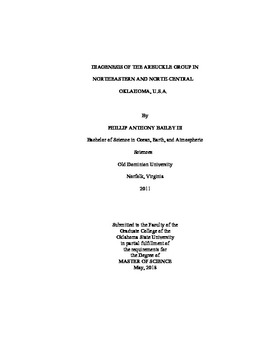| dc.contributor.advisor | Gregg, Jay Mason | |
| dc.contributor.author | Bailey, Phillip Anthony, III | |
| dc.date.accessioned | 2019-07-19T14:08:47Z | |
| dc.date.available | 2019-07-19T14:08:47Z | |
| dc.date.issued | 2018-12-01 | |
| dc.identifier.uri | https://hdl.handle.net/11244/320965 | |
| dc.description.abstract | Cambrian-Ordovician age Arbuckle Group carbonates host a wide variety of petroleum, mineral, and freshwater resources in Oklahoma. The studies that have been performed on the Midcontinent have shown the Arbuckle has been affected by both early and late diagenetic events with basinal fluids altering early diagenetic textures. Further constraining the origin, composition, and pathways of basinal fluid flow in northeastern and north-central Oklahoma would allow predictive characterizations of reservoir variability to be made. An integrated petrographic, geochemical, and fluid inclusion microthermometry study of the Arbuckle was performed using four subsurface cores to determine if the Arbuckle was modified by both early fluids (seawater or modified seawater) as well as late diagenetic fluids. The dominant lithology in the Arbuckle is cherty dolomite with interbedded quartz sandstones. Depositional fabrics observed range from subtidal to intertidal facies with some evidence of supratidal deposition. Replacement dolomite observed in all facies exhibit a range of very fine to coarse crystalline, planar to nonplanar textures. Carbon and oxygen isotope data (δ13C -3.84 to -0.63‰ VPDB and δ18O -7.92 to -3.08‰ VPDB) indicate much of the replacement dolomite is in equilibrium with early Ordovician seawater (and/or modified seawater) and partially recrystallized during the migration of warm, saline basinal fluids. Void-filling, coarse crystalline saddle dolomite cements plot as more negative δ18O values (-9.46 to -8.04 ‰VPDB) compared with replacement dolomite. Dolomite cements display a distinctive cathodoluminescent microstratigraphy containing two or more compositional zones. Fluid inclusion microthermometry of dolomite cements display increased homogenization temperatures (> 90ºC). Replacement dolomite and saddle dolomite cements did not display values of 87Sr/86Sr in equilibrium with early Ordovician seawater (87Sr/86Sr values ranged from 0.70969-0.71029) and likely indicate interaction with continental basement. This study concludes the Arbuckle Group underwent a complex diagenetic history that began sydepositionally (selected facies), modified by both early (seawater or modified seawater) fluids as well as late diagenetic basinal fluids. The basinal fluids are characterized as warm (90°C-155°C), saline (20-27 wt. % equivalent NaCl) fluids. These fluids are thought to be sourced from the Arkoma and/or Anadarko basins driven by gravity fluid flow mechanisms initiated during or after the Alleghenian/Ouachita orogeny. | |
| dc.format | application/pdf | |
| dc.language | en_US | |
| dc.rights | Copyright is held by the author who has granted the Oklahoma State University Library the non-exclusive right to share this material in its institutional repository. Contact Digital Library Services at lib-dls@okstate.edu or 405-744-9161 for the permission policy on the use, reproduction or distribution of this material. | |
| dc.title | Diagenesis of the Arbuckle Group in Northeastern and North-Central Oklahoma, U.S.A. | |
| dc.contributor.committeeMember | Pashin, Jack C. | |
| dc.contributor.committeeMember | Puckette, James O. | |
| osu.filename | BaileyIII_okstate_0664M_16037.pdf | |
| osu.accesstype | Open Access | |
| dc.description.department | Geology | |
| dc.type.genre | Thesis | |
| dc.type.material | Text | |
